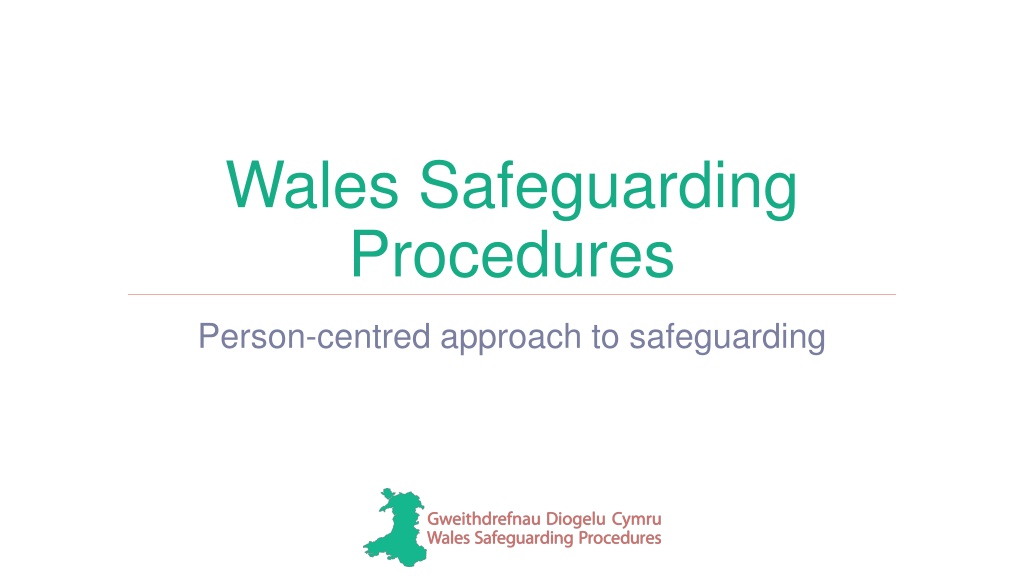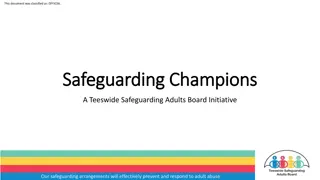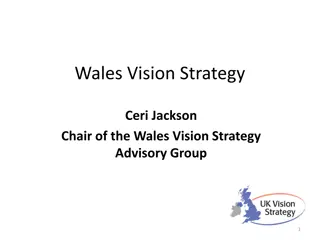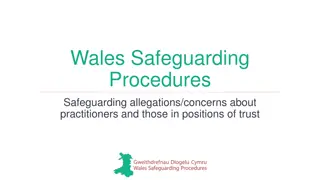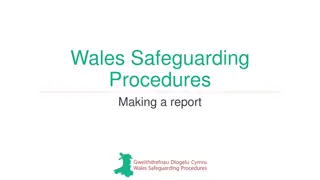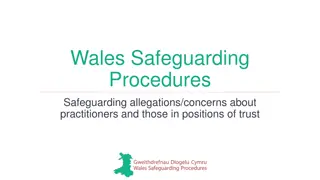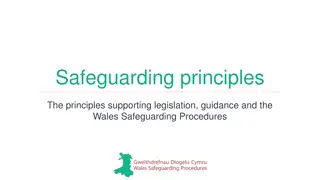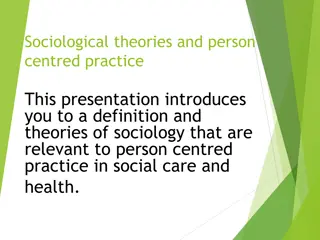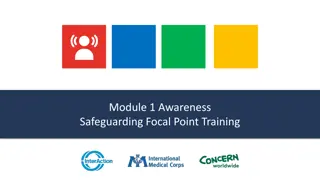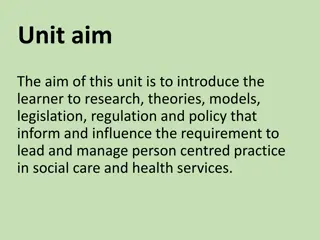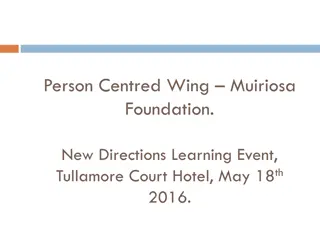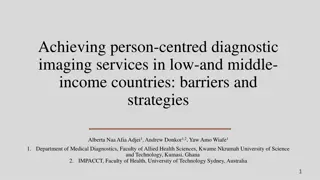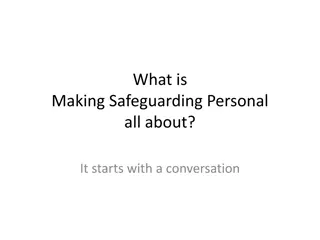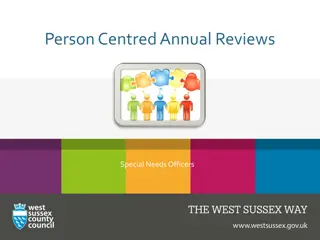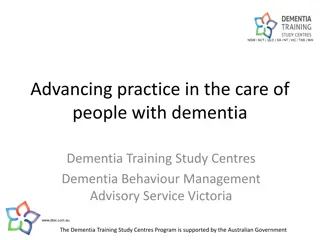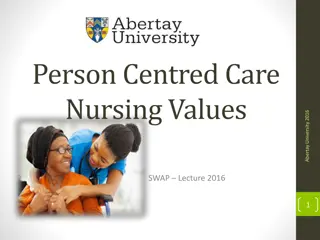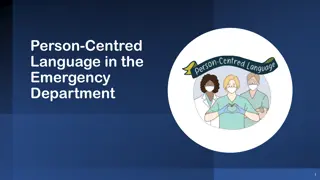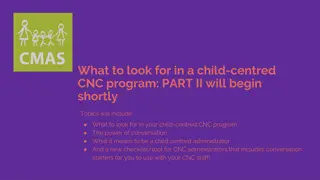Empowering Individuals through Person-Centred Safeguarding Practices in Wales
Promoting a person-centred approach to safeguarding in Wales, the Social Services and Well-being Act of 2014 emphasizes voice and control for individuals, focusing on prevention and early intervention to address issues promptly and effectively.
Download Presentation

Please find below an Image/Link to download the presentation.
The content on the website is provided AS IS for your information and personal use only. It may not be sold, licensed, or shared on other websites without obtaining consent from the author. Download presentation by click this link. If you encounter any issues during the download, it is possible that the publisher has removed the file from their server.
E N D
Presentation Transcript
Wales Safeguarding Procedures Person-centred approach to safeguarding
Social Services and Well-being (Wales) Act 2014 Voice and control of the individual Prevention and early intervention to prevent escalation of issues Well-being of the individual, to be promoted by all persons delivering functions under the Act Co-production between individual and agencies, across agencies and sectors, co-producing services and solutions Multi agency in this case, safeguarding is everybody s business Principles of the Act apply across all parts, including part 7 Safeguarding
Key values Two key values in safeguarding practice: 1) Safeguarding is everyone s responsibility 2) A person-centred approach
1) Safeguarding is everyones responsibility Effective safeguarding relies on working together to: identify when an adult or a family member is at risk understand the adult at risk's circumstances and care and support needs prevent their needs increasing Everyone should understand their responsibility to report when they suspect an adult is at risk
2) A person-centred approach You might hear other terms for the person-centred approach, including: patient-centred care client-centred support resident-centred care person-led support
A person-centred approach focuses on the needs of the person, rather than the needs of the service
How is this approach different? Old approach attitude: weknow best process-led system-focused doing things for/to the adult at risk no clear voice of the adult at risk Person-centred approach attitude: theyknow best adult at risk led sees the adult at risk as an individual outcome-focused / strengths-based doing things with/on behalf of the adult at risk
Person-centred approach Puts the needs of the person at the centre of decision- making Ensures decision-making is based on a clear understanding of: the personal outcomes the adult wishes to achieve and what matters to the individual Engages with the adult at risk throughout the safeguarding process Enables them to determine how they manage risks
Using a person-centred approach Put the person s rights and best interests first Consider their views, wishes and feelings Promote and respect their dignity Respect their characteristics, culture and beliefs Provideappropriate support to help them participate in decisions that affect them
What do you think about this statement? Mae n rhaid cadw r pwyslais ar arfarniad risg synhwyrol, nid ar geisio osgoi pob risg, pa bynnag yw r pris, ond yn hytrach, chwilio am gydbwysedd priodol a bod yn barod i oddef risgiau y gellir eu rheoli ac sy n fwy derbyniol a thalu r pris yn briodol er mwyn cyflawni rhywbeth da yn arbennig er mwyn cyrraedd hapusrwydd a lles y bobl oedrannus ac agored i niwed. The emphasis must be on sensible risk appraisal, not striving to avoid all risk, whatever the price, but instead seeking a proper balance and being willing to tolerate manageable or acceptable risks as the price appropriately to be paid in order to achieve some other good in particular to achieve the vital good of the elderly or vulnerable person s happiness. What good is it making someone safer if it merely makes them miserable? Pa ddaioni ddaw o ddiogelu rhywun os yw hynny n ei wneud yn ddigalon?
Person-centred approach to risk To make effective decisions you must make a calculated and reasoned assessment and analysis of the risk You must use reliable evidence Practitioners and the adult at risk should reach a shared understanding of any concerns You must regularly review the adult s risk assessments
6 safeguarding principles The principles of safeguarding
Safeguarding principles Principle 1: You must know the individual s personal outcomes and ensure they can communicate them effectively Principle 2: You must put the needs of the individual first, so they receive the care and support they need before a problem escalates
Safeguarding principles Principle 3: All practitioners who come into contact with adults at risk are trained and alert to their needs including any potential or suspected abuse or risk of abuse or neglect
Safeguarding principles Principle 4: All professionals share appropriate information without delay and have direct access to advice to discuss any concerns about an individual
Safeguarding principles Principle 5: All practitioners are able to use their professional judgement to put the individuals needs and personal outcomes at the centre of the system so that the right solution can be found for them
Safeguarding principles Principle 6: All professionals work in a multi-agency and co- operative way to safeguard and promote an adult at risk s well-being and regularly review progress against the outcomes set out in care and support plans
What is dignity? Dignity means: seeing and treating every person as a unique individual respecting other s views, choices and decisions not making assumptions about how people want to be treated working with care and compassion
What is respect? Respect means: valuing someone as a unique individual taking account of other people s views, opinions, feelings, wishes, rights, values and beliefs
What is enabling and empowering? Enabling means helping to create the conditions people need to do something Empowering means helping people to have the authority, freedom or confidence to do things
